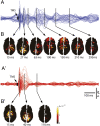Breakdown in cortical effective connectivity during midazolam-induced loss of consciousness
- PMID: 20133802
- PMCID: PMC2823915
- DOI: 10.1073/pnas.0913008107
Breakdown in cortical effective connectivity during midazolam-induced loss of consciousness
Abstract
By employing transcranial magnetic stimulation (TMS) in combination with high-density electroencephalography (EEG), we recently reported that cortical effective connectivity is disrupted during early non-rapid eye movement (NREM) sleep. This is a time when subjects, if awakened, may report little or no conscious content. We hypothesized that a similar breakdown of cortical effective connectivity may underlie loss of consciousness (LOC) induced by pharmacologic agents. Here, we tested this hypothesis by comparing EEG responses to TMS during wakefulness and LOC induced by the benzodiazepine midazolam. Unlike spontaneous sleep states, a subject's level of vigilance can be monitored repeatedly during pharmacological LOC. We found that, unlike during wakefulness, wherein TMS triggered responses in multiple cortical areas lasting for >300 ms, during midazolam-induced LOC, TMS-evoked activity was local and of shorter duration. Furthermore, a measure of the propagation of evoked cortical currents (significant current scattering, SCS) could reliably discriminate between consciousness and LOC. These results resemble those observed in early NREM sleep and suggest that a breakdown of cortical effective connectivity may be a common feature of conditions characterized by LOC. Moreover, these results suggest that it might be possible to use TMS-EEG to assess consciousness during anesthesia and in pathological conditions, such as coma, vegetative state, and minimally conscious state.
Conflict of interest statement
The authors declare no conflict of interest.
Figures



References
-
- Hobson JA, Pace-Schott EF. The cognitive neuroscience of sleep: neuronal systems, consciousness and learning. Nat Rev Neurosci. 2002;3:679–693. - PubMed
-
- Steriade M, Timofeev I, Grenier F. Natural waking and sleep states: a view from inside neocortical neurons. J Neurophysiol. 2001;85:1969–1985. - PubMed
-
- Ilmoniemi RJ, et al. Neuronal responses to magnetic stimulation reveal cortical reactivity and connectivity. Neuroreport. 1997;8:3537–3540. - PubMed
-
- Massimini M, et al. Breakdown of cortical effective connectivity during sleep. Science. 2005;309:2228–2232. - PubMed
Publication types
MeSH terms
Substances
Grants and funding
LinkOut - more resources
Full Text Sources
Other Literature Sources
Medical

